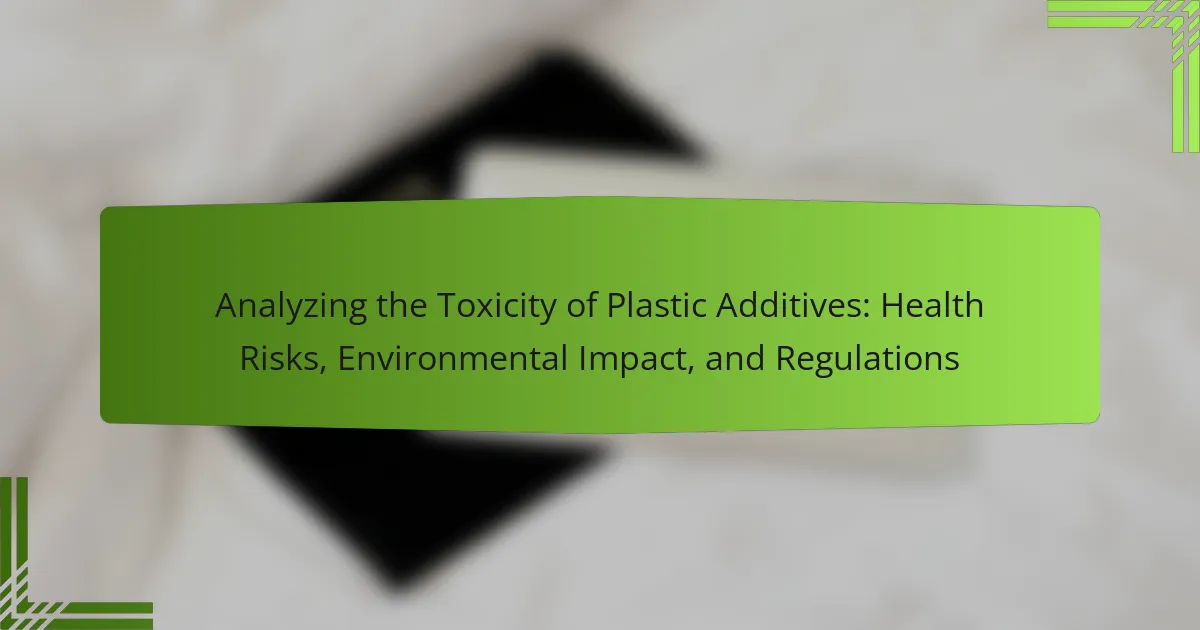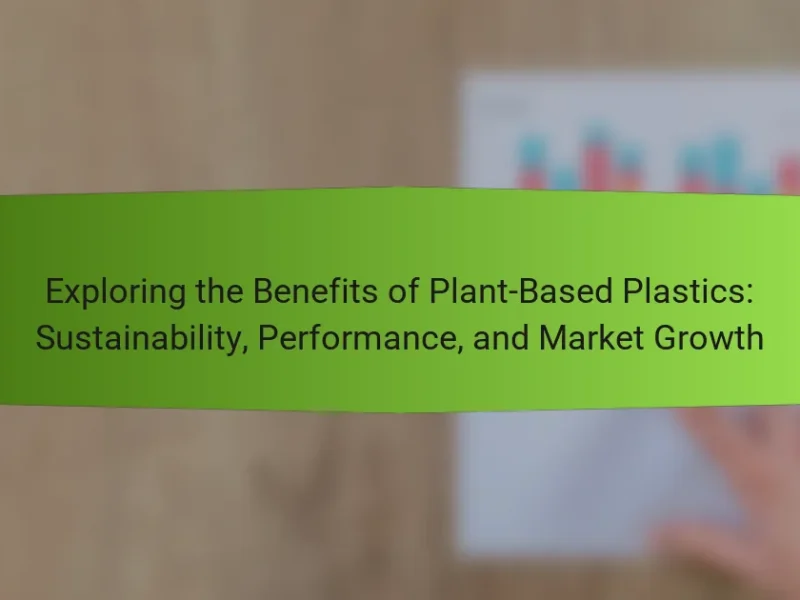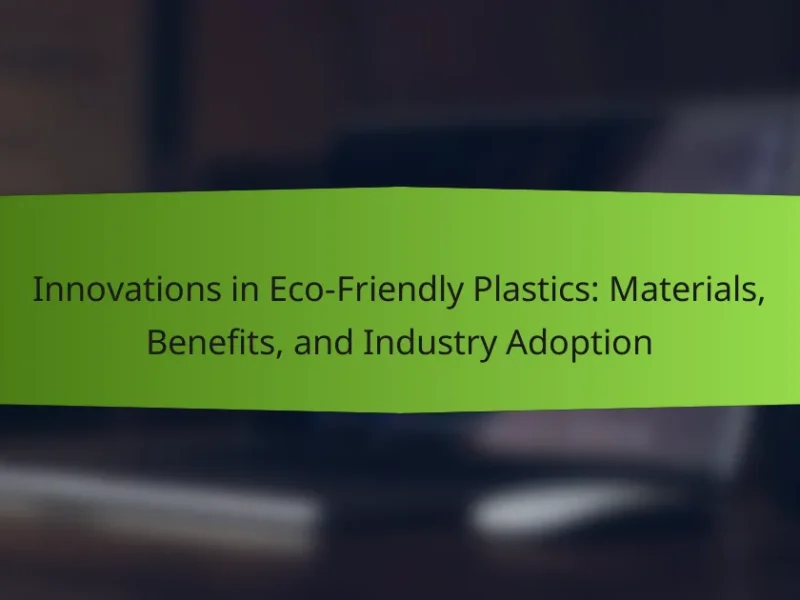Plastic additives are substances incorporated into plastics to enhance their properties, such as flexibility, durability, and resistance to heat and UV light. Common types of plastic additives include plasticizers, stabilizers, and fillers, which serve various functions across multiple industries, including packaging, automotive, and construction. However, these additives pose significant health risks, including endocrine disruption, reproductive toxicity, and carcinogenic effects, with chemicals like phthalates and bisphenol A (BPA) being particularly concerning. Additionally, plastic additives contribute to environmental pollution as they are non-biodegradable and can accumulate in ecosystems, posing risks to wildlife and human health. Regulatory frameworks, including oversight by the FDA and EPA in the United States and REACH in the European Union, aim to manage the use of these additives to ensure safety and environmental protection.

What are Plastic Additives and Why are They Used?
Plastic additives are substances added to plastics to enhance their properties. They are used to improve flexibility, durability, and resistance to heat and UV light. Common plastic additives include plasticizers, stabilizers, and fillers. For instance, plasticizers make plastics more flexible. Stabilizers prevent degradation from heat or light exposure. Fillers can reduce production costs and enhance strength. The global plastic additives market was valued at approximately $50 billion in 2021. This indicates their widespread use across various industries, including packaging, automotive, and construction.
How do Plastic Additives Enhance Material Properties?
Plastic additives enhance material properties by modifying their physical and chemical characteristics. These additives can improve flexibility, durability, and resistance to environmental factors. For example, plasticizers increase flexibility by reducing intermolecular forces within the polymer matrix. Stabilizers protect against degradation from heat and UV exposure, prolonging the material’s lifespan. Fillers can enhance strength and reduce production costs by providing bulk. Antioxidants prevent oxidative degradation, maintaining the integrity of the material over time. According to the American Chemistry Council, the use of additives can significantly enhance performance attributes, making plastics suitable for a wide range of applications.
What specific properties do different additives modify?
Different additives modify properties such as durability, flexibility, and thermal stability of plastics. For instance, plasticizers enhance flexibility and reduce brittleness. Stabilizers improve thermal stability and resistance to degradation. Fillers can increase strength and reduce costs. Antioxidants prevent oxidative degradation, extending the material’s lifespan. Flame retardants modify flammability properties to enhance safety. Each additive serves a specific function, impacting the overall performance of the plastic material. This modification is crucial in meeting industry standards and consumer demands.
How do these modifications impact the end-use of plastic products?
Modifications to plastic products, such as the addition of additives, significantly impact their end-use. These modifications can enhance properties like flexibility, durability, and resistance to heat. For example, plasticizers increase flexibility, making products suitable for applications like packaging and automotive parts. Conversely, some additives may introduce health risks, limiting their use in food-related applications. Toxicity concerns can lead to stricter regulations on specific additives, affecting product availability. Research indicates that certain plastic additives can leach into food, raising health concerns. This can result in reduced consumer acceptance and demand for modified plastics. Overall, the impact of these modifications is multifaceted, influencing both performance and regulatory compliance.
What Types of Plastic Additives Exist?
There are several types of plastic additives. These include plasticizers, stabilizers, fillers, colorants, flame retardants, and antioxidants. Plasticizers enhance flexibility and workability. Stabilizers prevent degradation from heat and UV exposure. Fillers improve mechanical properties and reduce costs. Colorants provide aesthetic appeal and branding. Flame retardants enhance fire resistance in plastics. Antioxidants protect against oxidative degradation. Each additive serves a specific function in plastic production and usage.
What are the common categories of plastic additives?
The common categories of plastic additives include stabilizers, plasticizers, fillers, colorants, and flame retardants. Stabilizers enhance the durability of plastics against heat and UV light. Plasticizers increase flexibility and workability of plastic materials. Fillers are used to reduce production costs and improve mechanical properties. Colorants provide aesthetic appeal by adding color to plastics. Flame retardants improve fire resistance in plastic products. Each category plays a distinct role in modifying the properties of plastics for various applications.
How do these categories differ in their applications?
The categories of health risks, environmental impact, and regulations differ in their applications by focusing on distinct aspects of plastic additives. Health risks pertain to the direct effects these additives have on human health, such as endocrine disruption or carcinogenicity. Environmental impact evaluates how these substances affect ecosystems, including toxicity to aquatic life and soil degradation. Regulations involve legal frameworks governing the use and disposal of plastic additives to mitigate their risks. Each category informs different stakeholders, from consumers to policymakers, on the implications of plastic additives. For instance, health risk assessments guide public health initiatives, while environmental impact studies inform conservation efforts. Regulatory frameworks are developed based on findings from both health and environmental studies, ensuring comprehensive management of plastic additives.
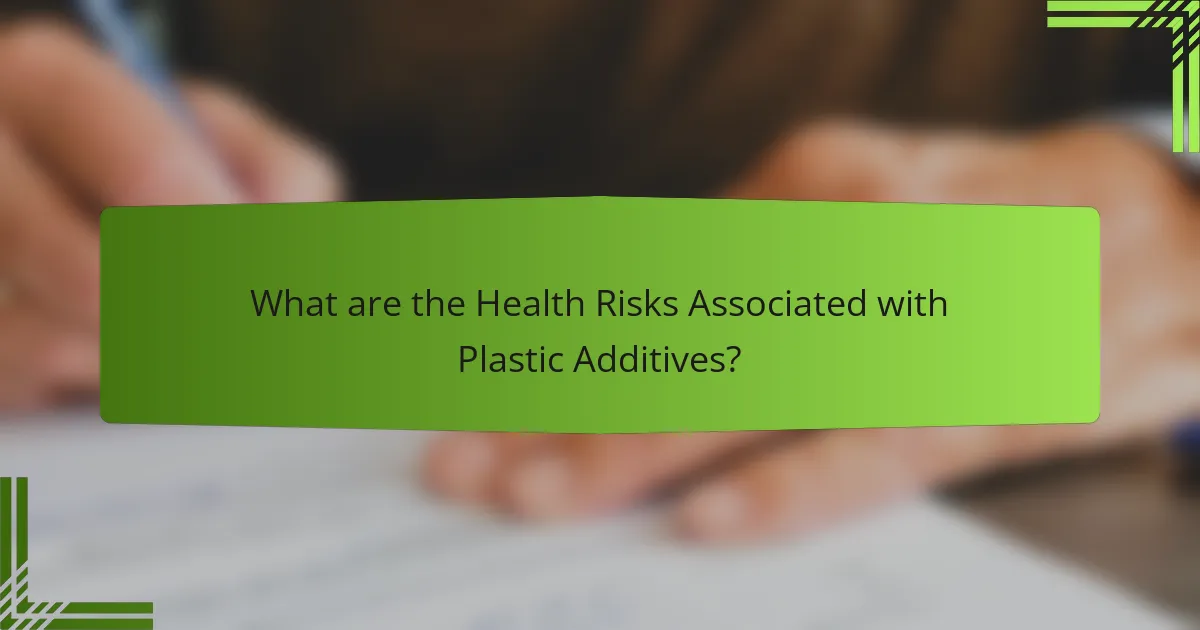
What are the Health Risks Associated with Plastic Additives?
Plastic additives pose several health risks, including endocrine disruption, reproductive toxicity, and carcinogenic effects. Chemicals like phthalates and bisphenol A (BPA) can interfere with hormonal systems. Studies show that phthalates are linked to reduced fertility in both men and women. BPA exposure has been associated with increased risks of breast and prostate cancers. Furthermore, certain additives may cause developmental issues in children. The World Health Organization has recognized these risks, highlighting the need for regulation. Research indicates that long-term exposure to these additives can lead to chronic health conditions.
How do Plastic Additives Affect Human Health?
Plastic additives can negatively impact human health. These substances, used to enhance the properties of plastics, can leach into food and beverages. Common additives include phthalates and bisphenol A (BPA). Exposure to these chemicals has been linked to hormonal disruptions. Studies show potential associations with reproductive issues and developmental problems in children. The World Health Organization has highlighted concerns over long-term exposure effects. Research indicates that certain additives may contribute to chronic diseases. Regulatory bodies are increasingly scrutinizing the safety of these substances.
What are the known toxic effects of specific additives?
Certain plastic additives are known to have toxic effects. Phthalates, commonly used as plasticizers, can disrupt endocrine function. They have been linked to reproductive and developmental issues in humans. Bisphenol A (BPA) is another additive that poses health risks. BPA exposure is associated with increased risk of heart disease and diabetes. Flame retardants, such as PBDEs, can cause neurodevelopmental problems in children. Heavy metals like lead and cadmium, often found in certain plastics, are toxic and can lead to organ damage. Research indicates that these additives can leach into food and beverages, further increasing exposure risks.
How can exposure to these additives occur?
Exposure to plastic additives can occur through direct contact and environmental pathways. Individuals may come into contact with these additives via consumption of contaminated food or beverages. Plastic packaging can leach additives into food, especially when heated. Inhalation of airborne particles from degraded plastics can also lead to exposure. Additionally, skin contact with plastic products may result in absorption of additives. Environmental exposure occurs when additives leach into soil and water systems. Studies have shown that certain additives, like phthalates and bisphenol A, can migrate from plastic into the environment. This migration can lead to widespread contamination, affecting both human health and ecosystems.
What Vulnerable Populations are Affected by Plastic Additives?
Vulnerable populations affected by plastic additives include children, pregnant women, and individuals with pre-existing health conditions. Children are particularly susceptible due to their developing bodies and higher exposure rates through play and consumption. Pregnant women face risks as plastic additives can cross the placenta, potentially affecting fetal development. Individuals with pre-existing health conditions, such as asthma or endocrine disorders, may experience exacerbated symptoms due to chemical exposure. Research indicates that these populations are at higher risk for adverse health effects linked to plastic additives, including hormonal disruptions and respiratory issues.
Why are children particularly at risk from plastic additives?
Children are particularly at risk from plastic additives due to their developing bodies and higher exposure levels. Their smaller size means a higher relative intake of chemicals compared to adults. Children often engage in behaviors like hand-to-mouth activity, increasing exposure to harmful substances. Additionally, their organs and systems are still maturing, making them more susceptible to toxic effects. Research indicates that certain plastic additives, like phthalates and bisphenol A (BPA), can disrupt hormonal development. Studies show that these chemicals are linked to developmental issues and long-term health problems in children. The American Academy of Pediatrics highlights these risks, emphasizing the need for protective measures.
How do gender and age influence susceptibility to health risks?
Gender and age significantly influence susceptibility to health risks. Research indicates that biological differences lead to varied health outcomes between genders. For instance, women often exhibit higher susceptibility to autoimmune diseases. Age also plays a critical role, with older adults generally facing greater health risks due to weakened immune systems.
Studies show that children are particularly vulnerable to environmental toxins, including plastic additives. Their developing bodies and higher metabolic rates increase exposure risks. Additionally, older individuals may experience more severe effects from the same toxins due to age-related physiological changes.
The interaction between gender and age can compound health risks. For example, older women may be more susceptible to certain health conditions than their male counterparts. This vulnerability can be attributed to hormonal changes and age-related decline in health.
In summary, both gender and age are crucial factors in determining susceptibility to health risks, particularly in the context of exposure to harmful substances like plastic additives.
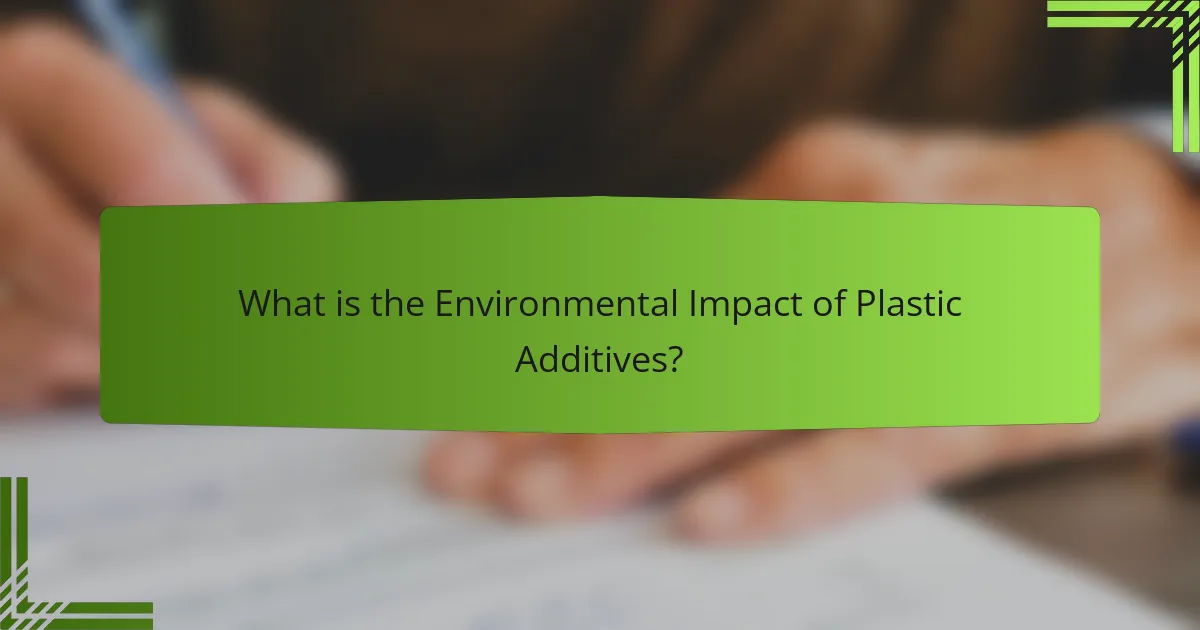
What is the Environmental Impact of Plastic Additives?
Plastic additives significantly contribute to environmental pollution. They are often non-biodegradable and accumulate in ecosystems. These additives can leach into soil and waterways, contaminating habitats. Studies show that microplastics, containing additives, are found in marine environments. This leads to ingestion by wildlife, causing harm to various species. Additionally, plastic additives can disrupt endocrine systems in animals. The presence of these chemicals in the food chain poses risks to human health. Research indicates that plastic additives can persist in the environment for decades.
How do Plastic Additives Contribute to Pollution?
Plastic additives contribute to pollution primarily through their leaching into the environment. These additives can include substances like phthalates and bisphenol A, which are known to be hazardous. When plastics degrade, these additives can escape into soil and waterways. This process can harm wildlife and disrupt ecosystems. Studies indicate that microplastics can carry these additives, spreading pollution further. Research shows that over 90% of marine organisms have been found to contain plastic additives. This contamination poses risks to human health as well, since these chemicals can enter the food chain. Consequently, the presence of plastic additives significantly exacerbates environmental pollution.
What are the pathways through which additives enter ecosystems?
Additives enter ecosystems through several pathways. These include direct leaching from plastic products into soil and water. Rainwater can wash additives from landfills into nearby waterways. Runoff from agricultural areas can transport additives used in farming into aquatic systems. Airborne particles can deposit additives onto soil and water surfaces. Wildlife can ingest additives through contaminated food sources. Wastewater discharge from industrial processes can introduce additives into aquatic environments. Each of these pathways contributes to the accumulation of additives in ecosystems, impacting both environmental and human health.
How do these pollutants affect wildlife and habitats?
Pollutants from plastic additives adversely affect wildlife and habitats. They can lead to bioaccumulation in species, disrupting food chains. Aquatic animals ingest microplastics, which can cause digestive issues and toxicity. Terrestrial animals may consume contaminated plants or prey, leading to health problems. Pollutants also alter habitat conditions, reducing biodiversity. For example, chemicals can harm reproductive systems in fish, leading to population declines. Additionally, pollutants can degrade ecosystems, making them less resilient to environmental changes. Research indicates that plastic pollution has been found in over 700 marine species, demonstrating its widespread impact.
What Long-Term Environmental Consequences Can Arise?
Long-term environmental consequences of plastic additives include ecosystem disruption and biodiversity loss. These additives can leach into soil and water, contaminating natural habitats. Chemical accumulation in organisms leads to bioaccumulation and biomagnification in food chains. For instance, microplastics have been found in marine life, affecting species health and reproduction. Persistent organic pollutants from plastics can remain in the environment for decades, causing long-lasting damage. Research indicates that plastic pollution contributes to habitat degradation, particularly in oceans and waterways. The World Economic Forum reports that by 2025, there could be more plastic than fish in the ocean by weight.
How do plastic additives affect soil and water quality?
Plastic additives negatively affect soil and water quality. These additives, such as phthalates and bisphenol A, can leach into the environment. They contaminate soil and water sources, disrupting ecosystems. Research indicates that these chemicals can alter microbial communities in soil. This disruption can lead to reduced soil fertility and plant health. In water, plastic additives can accumulate in aquatic organisms. This bioaccumulation poses risks to the food chain and human health. Studies show that contaminated water can lead to toxic effects on fish and other wildlife. The persistence of these additives in the environment exacerbates their harmful impact.
What are the implications for human health and food safety?
Plastic additives can pose significant implications for human health and food safety. Many additives, such as phthalates and bisphenol A (BPA), are known endocrine disruptors. These substances can leach into food and beverages, especially when exposed to heat or acidic conditions. Research indicates that chronic exposure to these chemicals is linked to reproductive issues, developmental problems, and increased risk of certain cancers.
The World Health Organization (WHO) has highlighted concerns regarding the migration of plastic additives into food products. Studies show that over 90% of plastic food containers contain additives that can migrate into food. This migration raises serious safety concerns, particularly for vulnerable populations, including pregnant women and children.
Regulatory bodies, like the U.S. Food and Drug Administration (FDA), monitor plastic additives but face challenges in keeping up with emerging research on their health impacts. Therefore, understanding the implications of plastic additives on human health and food safety is crucial for public health policies and consumer protection.
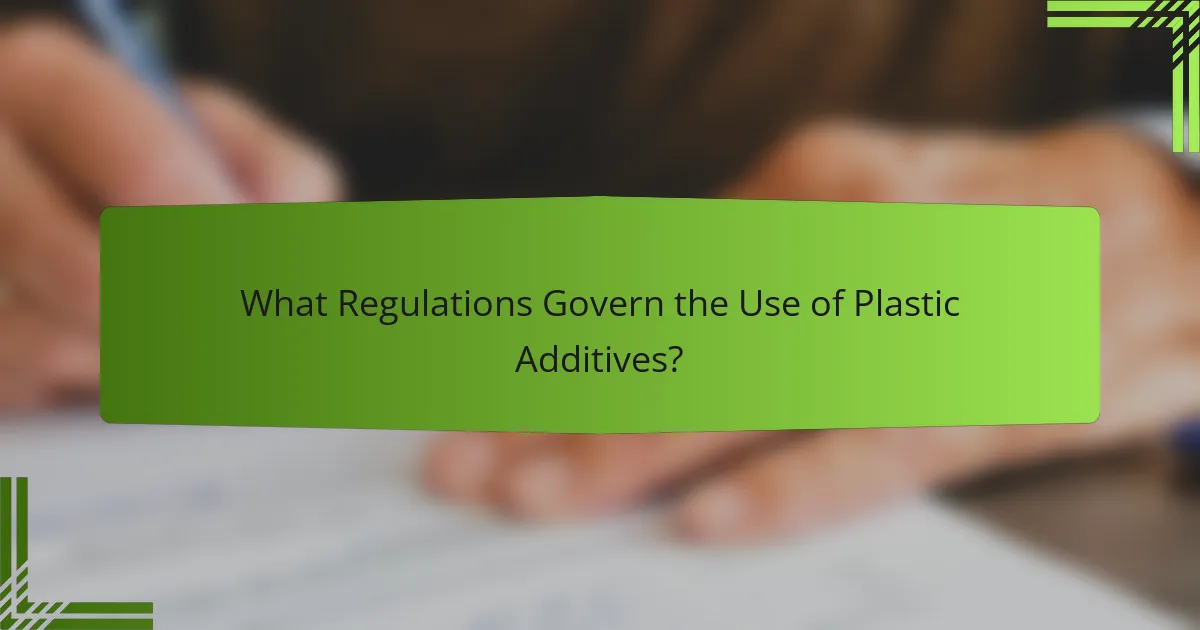
What Regulations Govern the Use of Plastic Additives?
Regulations governing the use of plastic additives include various national and international standards. In the United States, the Food and Drug Administration (FDA) oversees additives used in food-contact plastics. The Environmental Protection Agency (EPA) regulates chemical substances under the Toxic Substances Control Act (TSCA). The European Union has established regulations through REACH (Registration, Evaluation, Authorisation, and Restriction of Chemicals) and the Plastics Directive. These regulations aim to ensure safety and environmental protection. Compliance with these regulations is mandatory for manufacturers. Non-compliance can lead to penalties and product recalls.
What are the Current Regulations on Plastic Additives?
Current regulations on plastic additives vary by region and are primarily governed by safety standards. In the United States, the Food and Drug Administration (FDA) oversees the use of plastic additives in food contact materials. The FDA requires that any additive used in food packaging must be proven safe through rigorous testing. In the European Union, the Registration, Evaluation, Authorisation and Restriction of Chemicals (REACH) regulation mandates that manufacturers register chemical substances, including plastic additives, and demonstrate their safety. Additionally, the EU’s Plastics Regulation sets specific limits on hazardous substances in plastic products. These regulations aim to minimize health risks and environmental impacts associated with plastic additives. Compliance with these regulations is essential for manufacturers to ensure consumer safety and environmental protection.
Which organizations are responsible for regulating these additives?
The organizations responsible for regulating plastic additives include the U.S. Food and Drug Administration (FDA) and the Environmental Protection Agency (EPA). The FDA oversees additives used in food contact materials. The EPA regulates chemicals under the Toxic Substances Control Act. Additionally, the European Food Safety Authority (EFSA) evaluates food additives in the European Union. The European Chemicals Agency (ECHA) manages the registration, evaluation, and authorization of chemicals in Europe. These organizations ensure that plastic additives meet safety standards and do not pose health risks.
What specific regulations exist for high-risk additives?
High-risk additives are regulated under various frameworks. In the United States, the Food and Drug Administration (FDA) oversees food additives, including high-risk substances. The Federal Food, Drug, and Cosmetic Act mandates safety evaluations for these additives before approval.
In the European Union, Regulation (EC) No 1935/2004 governs materials intended to come into contact with food. This regulation requires that high-risk additives do not transfer constituents to food in quantities that could endanger human health.
Additionally, the REACH Regulation (Registration, Evaluation, Authorisation, and Restriction of Chemicals) requires manufacturers to register high-risk substances and assess their safety. These regulations are designed to protect public health and the environment from potential hazards associated with high-risk additives.
How Effective are Current Regulations in Protecting Health and Environment?
Current regulations are moderately effective in protecting health and the environment from plastic additives. Regulations like the Toxic Substances Control Act (TSCA) in the U.S. require some testing of chemical substances. However, many plastic additives remain unregulated or inadequately assessed. A report from the European Chemicals Agency identified over 1,000 substances of concern. These substances can leach into the environment and pose health risks. Studies show that certain additives are linked to endocrine disruption and other health issues. Furthermore, enforcement of existing regulations varies significantly across jurisdictions. This inconsistency can lead to gaps in protection. Overall, while regulations provide a framework, they often lack the comprehensiveness needed for full effectiveness.
What challenges exist in enforcing these regulations?
Challenges in enforcing regulations on plastic additives include lack of standardization, insufficient funding, and limited resources. Many regulations vary by region, creating confusion for manufacturers. Enforcement agencies often operate with inadequate budgets, hindering their ability to monitor compliance effectively. Additionally, the complexity of chemical formulations makes it difficult to assess safety accurately. The rapid pace of innovation in the plastic industry can outstrip regulatory frameworks. Furthermore, industry lobbying can influence regulatory decisions, leading to weaker enforcement. These factors collectively undermine the effectiveness of regulations aimed at ensuring safety and environmental protection.
How can regulations be improved for better safety?
Regulations can be improved for better safety by implementing stricter testing requirements for plastic additives. Enhanced testing protocols can identify harmful substances before they enter the market. Additionally, increasing transparency in the approval process will allow for greater scrutiny by independent researchers. Regular reviews of existing regulations can ensure they adapt to new scientific findings. Collaboration with international regulatory bodies can harmonize safety standards globally. Public engagement in the regulatory process can also enhance accountability. Evidence from studies shows that stricter regulations lead to reduced health risks associated with toxic exposure. For example, the European Union’s REACH regulation has significantly improved chemical safety in consumer products.
What Best Practices Can Be Implemented to Mitigate Risks from Plastic Additives?
Implementing best practices to mitigate risks from plastic additives includes using safer alternatives and enhancing regulations. Manufacturers should prioritize non-toxic materials in production. Substituting harmful additives with safer options reduces health risks. Regular testing for toxic substances in plastic products is essential. Educating consumers on safe disposal methods minimizes environmental impact. Promoting recycling and circular economy practices helps reduce plastic waste. Collaboration among stakeholders strengthens regulatory frameworks. These practices collectively contribute to safer plastic use.
How can manufacturers reduce harmful additives in their products?
Manufacturers can reduce harmful additives in their products by reformulating their materials. They can substitute toxic additives with safer alternatives. For example, using bio-based plastics can minimize harmful chemical exposure. Implementing stricter quality control measures can help in identifying and eliminating harmful substances. Manufacturers should also invest in research and development for safer materials. Compliance with regulations can guide the reduction of harmful additives. According to the European Union’s REACH regulation, manufacturers must assess the safety of chemicals used in products. This creates a framework for reducing harmful additives effectively.
What role can consumers play in minimizing exposure to plastic additives?
Consumers can minimize exposure to plastic additives by making informed purchasing choices. They should prioritize products labeled as free from harmful chemicals. This includes selecting items made from natural materials or those certified as non-toxic. Consumers can also reduce plastic use by opting for reusable containers and bags. Avoiding microwaving food in plastic containers can further decrease additive leaching. Research indicates that certain plastic additives, like BPA, can disrupt hormonal balance. By being proactive, consumers can significantly lower their exposure to potentially harmful substances.
The main entity of the article is plastic additives, which are substances added to plastics to enhance their properties, such as flexibility, durability, and resistance to environmental factors. The article provides an in-depth analysis of the health risks associated with plastic additives, including endocrine disruption and carcinogenic effects, as well as their significant environmental impact, including pollution and ecosystem disruption. It also discusses the regulatory frameworks governing the use of these additives, highlighting challenges in enforcement and the need for improved safety measures. Key topics include the types of additives, their specific properties, the implications for human health and food safety, and best practices for mitigating risks.
